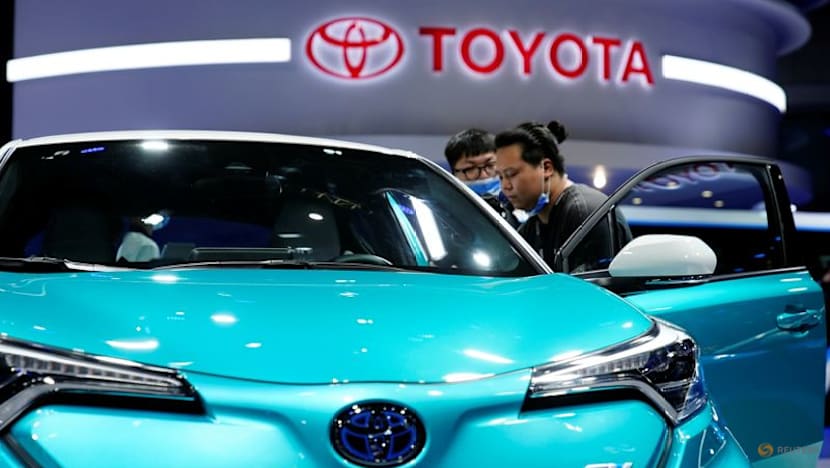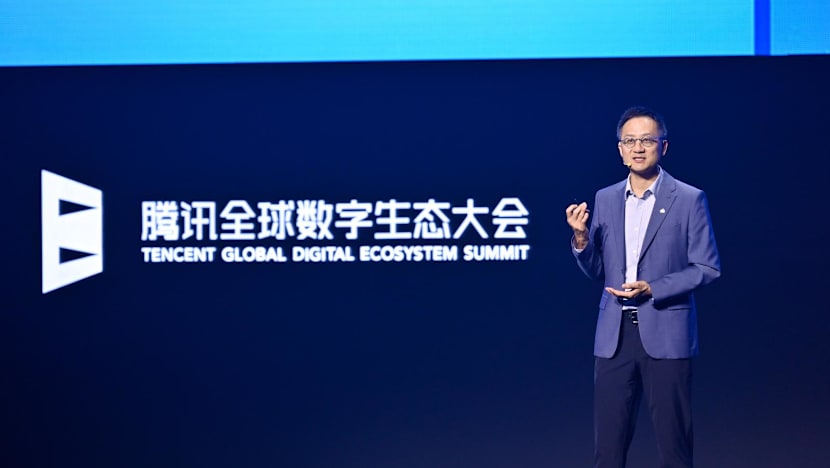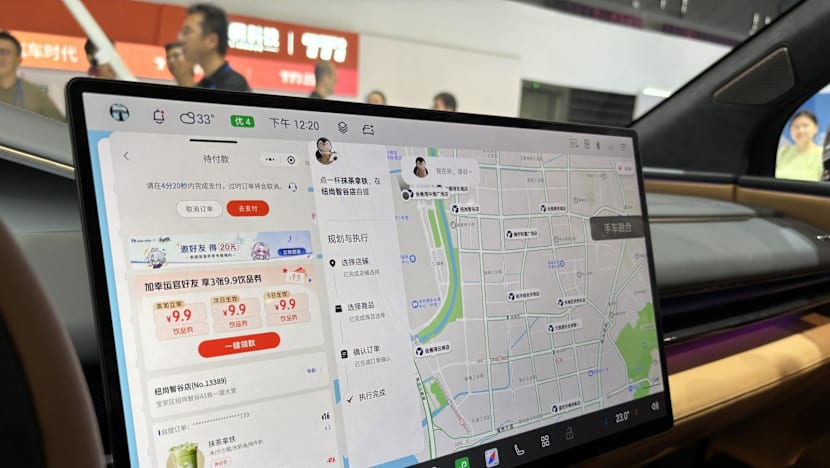A new wave of plug-and-play AI tech is emerging in China. Can it deliver?
China’s plug-and-play AI is powering everything from hotels to hospitals and factories, but affordability remains the key test.

H World Group will launch “Hua Xiao AI” later this year, an AI concierge built with Tencent Cloud that can handle guest services, from room queries to local recommendations. (Photo: H World Group)

This audio is generated by an AI tool.
SHENZHEN: Ordering bottled water at a hotel would usually mean calling room service and waiting for staff to deliver it later.
But Chinese AI could soon speed up that process: with a digital concierge logging the request and dispatching a delivery robot to your door just minutes later.
The service, known as Hua Xiao AI, will roll out later this year across H World Group hotels in China, one of the country’s largest hotel chains that also owns the Ji Hotel brand, with presence in Singapore, and soon, Malaysia.
This digital concierge can handle more than 30 tasks, from answering room queries to giving recommendations on nearby dining and attractions. It is powered by Tencent Cloud’s Agent Development Platform, a plug-and-play system built on Large Language Models (LLMs). LLMs are the same underlying AI technology that powers apps like ChatGPT.
“In the future, the strength of a company will not lie in its own capabilities, but in its ability to connect with the best resources in society,” said H World CEO Jin Hui, who was speaking at the Tencent Global Digital Ecosystem Summit last week.
China’s AI sector is rapidly evolving in line with Beijing’s ambitious “AI Plus” strategy, which seeks to integrate AI technology into 90 per cent of major industries by 2030.
A new wave of plug-and-play tech is emerging, designed to streamline processes and make AI adoption much simpler.
From an online platform that lets firms build their own digital staff, to a computer loaded with AI models like DeepSeek, these plug-and-play tools promise to make adopting AI as easy as turning on a device.
All users need to do is input commands or data, and the machine does the rest - whether it's answering questions, generating reports or carrying out routine tasks. Such devices are already being used in settings like hospitals, schools and government offices to carry out tasks like teaching and research support.
In practice, it’s as straightforward as plugging it in, typing or speaking a request, and getting results within seconds.
Sales of all-in-one machines are expected to surge fivefold, from 150,000 units in 2025 to 720,000 by 2027, with market value rising from 123.6 billion yuan to over 520.8 billion yuan, according to data released by Zheshang Securities.
“Industries such as manufacturing and retail, which have weaker hardware development capabilities, are more willing to adopt all-in-one machines,” noted Lu Yanxia, research director at IDC China, a global market research and consulting firm.
Lu believes demand would mostly come from government offices, state-owned firms and industries like manufacturing and retail, which often lack the ability to develop such technology on their own.
But other experts have cautioned that expectations may be outpacing reality.
“Tech companies try to exaggerate,” said Mehran Mazandarani, an independent AI consultant based in Shenzhen - who compared the current wave of AI products to the early days of personal computers: when companies would flood the market but only a few with the “best integration and service support” survived.
“Sometimes what they (tech companies) have is just nothing special,” Mazandarani said.
THE BUSINESS OF PLUG-AND-PLAY AI
According to a UBS forecast, Chinese AI agents could start turning profits by 2026.
An AI agent is software that can act on its own to complete tasks using data and tools - for example, searching the web, planning trips or answering customer queries.
“2026 (will be) the year of agent monetisation in China,” Sundeep Gantori, equity strategist at UBS Global Wealth Management CIO said in an interview with the South China Morning Post on Sep 4.
One major catalyst has been Hangzhou start-up DeepSeek, which drew global attention earlier this year for its powerful, low-cost R1 model. It revealed training costs of just US$294,000 - a fraction of what Western rivals like OpenAI would typically spend.
Gantori expects monetisation to accelerate as models like DeepSeek’s R2 become more advanced. “We expect to see greater monetisation,” Gantori said.
At the same time, demand for all-in-one LLM machines is on the rise.
Depending on specifications, mainstream all-in-one LLM machines can cost from 500,000 yuan (US$68,000) to 5 million yuan, according to a 2025 report by the LeadLeo Research Institute.
For some, the appeal is peace of mind. “In the case of all-in-one machines, it provides easy access to models such as DeepSeek without worries about data security, since it’s all on your own machine,” Wendy Chang, an analyst at the Mercator Institute for China Studies (MERICS), told CNA.
The biggest winners for now would be equipment makers behind AI chips and servers, she added.
Alex Kot, a professor at the Shenzhen MSU-BIT University, agreed. “One of the key things is data policies and reliability. There has always been a niche market for that purpose,” Kot said.
But he noted the limitations.
“If the data changes, or if a better algorithm comes out, (users) may have to upgrade,” he said. “That’s where the all-in-one can run into problems.”
By contrast, agent platforms are marketed as toolkits for enterprises - frameworks that build and embed customised “digital staff” into workflows.
Agent platforms typically run online, while all-in-one machines can also operate offline for added security.
The appeal is clearest in industries where information is complex and customer demand is high, experts said.
For Chinese state-owned carmaker FAW Toyota, that meant managing a sprawling library of manuals and guides.
The company turned to Tencent Cloud’s platform. Its customer service bot boosted efficiency from 37 to 88 per cent, while monthly consultations jumped from 15,000 to 24,000.
Its customer service team was cut from 12 staff members to just two, delivering both cost savings and a smoother user experience, said Wang Jinwei, its head of new business.

In Shenzhen’s Bao’an District, a service robot called Xiaobao assists residents with tasks like applying for government subsidies online.
Xiaobao is also able to verify IDs, scan documents and print receipts, performing services available at most district centres.
And some companies are already seeing returns. Cybersecurity firm TopSec reported that its AI machines have been deployed in government offices, hospitals and enterprises, generating more than 2 million yuan in sales, with annual revenue expected to top 100 million yuan.
“AI technology landing in real scenarios achieves efficiency breakthroughs and drives profit growth,” said Dowson Tong, Senior Executive Vice President of Tencent, in a keynote speech made at the recent Global Digital Ecosystem Summit.
AI intelligent agents “will become a key vehicle” during this application era, Tong added.

Industry giants are also betting big on this shift. Huawei struck a similar note in its Intelligent World 2035 report released in September, saying that AI agents would become the long-term driver of enterprise productivity, much like how apps defined the mobile internet era.
Alibaba Cloud pledged 380 billion yuan over three years for AI and cloud infrastructure.
Chairman Eddie Wu said Alibaba aims to make its open-sourced Qwen models the “operating system of the AI era” - paired with toolkits to speed deployment across devices and industries.
The company also unveiled AgentBay, a multimodal platform for building end-to-end agents, and Lingyang AgentOne - an “AI workspace” for integrating marketing, customer service and operations.
But regardless of the platform, experts said the appeal is strongest for firms wanting to adopt AI tools and practices but lacking the necessary expertise.
“Sometimes clients are not very familiar with the technology behind it, so they prefer turnkey solutions,” said Kot.
Chang from MERICS added that the key selling point was accessibility. “Agent platforms allow you to build a custom solution for your business using graphical interfaces, without deep coding knowledge,” she said.
For Mazandarani, the choice is stark - companies can either “use what already exists in the market” by relying on LLM agents and some open-source tools, or invest heavily to build new systems from scratch that surpass existing models.
“Only giant companies can do this,” he added.
TAKING AI OVERSEAS
China’s tech giants are no longer just pitching generative AI products at home - they are increasingly taking their models overseas.
Voice-recognition giant iFlytek launched its Spark Enterprise Intelligent Agent Platform with a suite of all-in-one LLM machines, already used in China’s government, finance and energy sectors.
Trials are now underway in Singapore, Saudi Arabia and Qatar, the company said.
“We are committed to providing truly usable, reliable AI solutions for global enterprises through a mature product and service system,” Zhou Chuanfu, General Manager of iFlytek’s Overseas Division, told CNA.
Tencent is also expanding abroad, leveraging its overseas cloud operations to compete globally. It has been its fastest-growing segment, said Tong, recording “high double-digit growth over the past few years”.
“We try to be very flexible in how to deploy our technology and meet the very different needs of different types of customers,” Tong said.
Among the early adopters is Indosat Ooredoo Hutchison, one of Indonesia’s largest telecommunications providers, which is using Tencent to power its Bima super app with content delivery networks and mini-programs.
CEO Vikram Sinha told CNA that both sides were discussing co-investment opportunities in infrastructure to speed up AI adoption.
“When it comes to (applying) AI, China is far ahead and very impressive,” Sinha said.

Analysts said China’s edge is speed and scale. “If each product only brings 0.1 per cent profit, when the number of products increases, the whole profit rises,” said Mazandarani.
“Other companies outside China don’t have this potential at such scale.”
IDC’s Lu said China’s strength in AI comes from years of operating at scale in consumer internet.
“Companies have built up technical experience under massive user bases, high concurrency and heavy data traffic,” she said.
“They have also explored a wide range of consumer-facing applications, giving them an edge when taking AI agents overseas compared with global peers.”
There is demand across industries, said Kot. “All industries, all segments, you can see that they will need AI because it’s very much data-driven, and it works much better than traditional code.”
He called regulation a double-edged sword, pointing to China's cultural approach to data.
Chinese companies can “easily share different types of data” like one’s salary, age or birthday, Kot said.
“It’s much easier for them to get hold of data. AI is very much based on data, so that’s why China can move so fast.”
Taking Chinese AI tech overseas means navigating different countries’ data laws.
In Indonesia, digital sovereignty is a priority under its new Personal Data Protection Law, which took effect last year.
But Indosat’s Sinha cited Tencent’s WeChat as proof of its ability to scale securely.
“Flexibility combined with humility is a superpower … You can’t lock yourself, and in today’s world that is extremely important,” he said.
“Tencent has been very clear and supportive. Data sovereignty is not only about being in the country, it is also about following all the regulations of the country.”
Others remain sceptical. Chang of MERICS doubted that simple generative AI solutions would find traction overseas.
“The platforms will also tend to be more localised worldwide, and we won’t see Chinese platforms have a big share internationally,” Chang said.
Tencent’s Tong stressed that localisation is key when working with companies abroad, citing Saudi Arabia as an example.
“We are also building local teams and working with system integrators to ensure our solutions are fully aligned with Saudi business and regulatory environments,” he said.
AI FOR ALL - OR JUST BIG CHAINS?
At KFC China, the newest “assistant” is not a trainee manager but an AI system. Known as Q-Smart, the tool connects through a smartwatch or earpiece and is able to perform functions like flagging low stock, reminding staff to confirm orders and adjusting preparation plans in real time.
Unveiled by Yum China in June, Q-Smart has cleared initial lab tests and is now being piloted in select outlets. The company says the aim is to ease the load on frontline managers, who must juggle schedules, inventory and safety checks.
For smaller players, however, AI remains out of reach.
“Small restaurants still want to use AI, but it’s too expensive,” said Joyce Lee, a veteran consultant who has advised thousands of food and beverage firms in China and abroad over the past 25 years.
“Only large chains with hundreds of outlets or big banquet kitchens can afford it.”
She has seen tech firms aggressively pitch AI to small and medium enterprises. Many are hesitant, she said, because while AI can technically process huge volumes of orders, smaller restaurants lack the capacity to keep up.
“Suppose (a machine) processes 10,000 orders at once, but the kitchen can’t possibly fulfil them. That becomes a problem,” Lee said.
Sometimes, she added, the technology is simple but once labelled as AI, it can intimidate businesses. “Of course they’re hesitant, because they’ll ask: how many meals can this machine actually prepare in an hour? That’s when the cost issue becomes clear.”
Her concerns highlight a broader hesitation. Plug-and-play generative AI may be China’s latest bandwagon, but the real test is whether it delivers lasting value, experts said.
“Not every project will succeed, but the ones that do could reshape entire industries,” said Mazandarani.
“In China, the real competition may come down to the service layer - how easy it is to deploy, update and get support. The companies that can give the best service after selling will come on top.”

Kot from Shenzhen MSU-BIT University added a note of caution: “That’s why sometimes we call it hype, because expectations don’t always line up with what AI can really do in different industries.”
AI models often perform well when trained on their own data but ultimately falter when exposed to unfamiliar situations, he said. “They rarely see cases where things don’t work. That’s why, in abnormal situations, AI can fail - it simply doesn’t know what to do.”
For Lee, the bottom line is more practical.
She has seen AI priced anywhere from a few hundred thousand yuan to over 100 million.
“If AI solutions are priced like luxury items, they simply won’t take off,” she said.
“The real test will be whether AI can become practical and affordable for the everyday operator.”
Editor's note: An earlier version of this article said the H World hotel group has presence in Thailand. The company has since clarified that it does not have hotels in operation there.



















